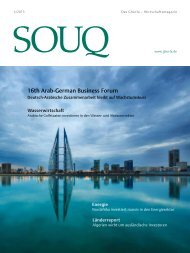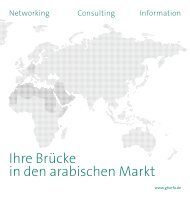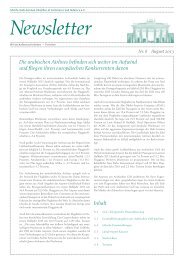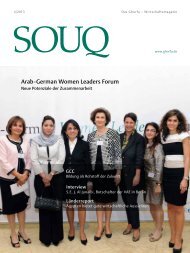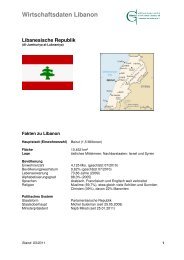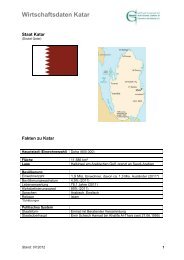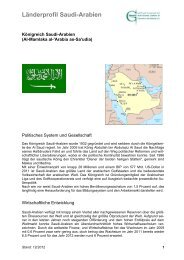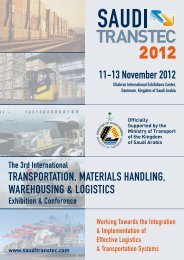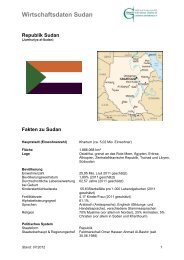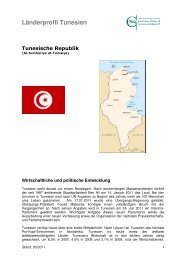Saudi-Arabien Wirtschaftshandbuch Saudi Arabia Business ... - Ghorfa
Saudi-Arabien Wirtschaftshandbuch Saudi Arabia Business ... - Ghorfa
Saudi-Arabien Wirtschaftshandbuch Saudi Arabia Business ... - Ghorfa
Sie wollen auch ein ePaper? Erhöhen Sie die Reichweite Ihrer Titel.
YUMPU macht aus Druck-PDFs automatisch weboptimierte ePaper, die Google liebt.
46<br />
The hydrocarbon sector (oil and gas) is of primary importance<br />
for the <strong>Saudi</strong> economy. Around 34% of the gross<br />
domestic product, almost 90% of the exports and 82% of<br />
the state income are generated by this sector. On the other<br />
hand, this one-sided dependence of the economy on oil<br />
and gas harbours certain risks as shown in the past when<br />
the oil price dropped dramatically. For this reason, the<br />
<strong>Saudi</strong> government is concentrating on a course which is<br />
set to diversify the economic structure and export base.<br />
The recent development of energy-intensive industrial<br />
branches e.g. petrochemicals, have proven to be highly<br />
successful.<br />
With production capacities of 11 million barrels every<br />
day, <strong>Saudi</strong> <strong>Arabia</strong> produced 9.21 million barrels a day<br />
in 2006 compared to 9.35 million barrels a day in 2005.<br />
By the end of 2003, 91 oil fields had been developed including<br />
the world’s largest on-shore field in Ghawar and<br />
the offshore field Safanyiah. The extensive oil reserves,<br />
the favourable prospects for developing further oil fields<br />
and the favourable production costs are a guarantee that<br />
<strong>Saudi</strong> <strong>Arabia</strong> will remain the leader of the growing world<br />
oil production in the long-term.<br />
The oil output was increased from 2,589 million barrels<br />
in 2002 to 3,361 million barrels in 2006, which equates<br />
to an annual average rise of around 7%. However the<br />
Kingdom has had unused production capacities for years.<br />
At a daily production of 9.0 million barrels (November<br />
2007) there is a surplus production capacity of 2.0 million<br />
barrels a day. Due to the expected rise in the demand<br />
for oil on the world market, <strong>Saudi</strong> <strong>Arabia</strong> has recently<br />
been attempting to explore and/or develop new oil fields.<br />
As a consequence, the new oil fields Qatif and Abu Safa<br />
went operational at the end of 2004. The current plans<br />
stipulate that the production capacity will be raised to<br />
12.5 million barrels a day by 2009. The International<br />
Energy Agency (IEA) estimates that <strong>Saudi</strong> <strong>Arabia</strong> will<br />
increase its current 12% share of the world oil production<br />
to 18% over the next 20 years. At the same time, the daily<br />
production capacity will be more than doubled to 22.5<br />
million barrels a day.<br />
The natural gas reserves in <strong>Saudi</strong> <strong>Arabia</strong> were estimated<br />
at 253 billion cubic feet (cft) in 2006, which corresponds<br />
to around 4% of the world gas reserves. These gas reserves<br />
put the Kingdom in fourth place behind Russia, Iran<br />
and Qatar in the world. Two thirds of these gas reserves<br />
comprise associated gas (gas bound inside the crude oil).<br />
According to information provided by the <strong>Saudi</strong> ARA-<br />
MCO, around 15% of the reserves have been tapped into<br />
already which means that there is great potential for the<br />
production of natural gas in the future. At the moment,<br />
<strong>Saudi</strong> <strong>Arabia</strong> produces around 2.5% of the world’s gas<br />
production, which is low compared to the leading producing<br />
countries: Russia (22%), USA (18%) and Canada<br />
(6%). On a global scale, <strong>Saudi</strong> <strong>Arabia</strong> still lies behind<br />
Iran (4%) and Great Britain (3%).<br />
At the start, only associated gas from the crude oil output<br />
was produced. In 1975 the Master-Gas-System was<br />
established during an extensive investment program; its<br />
first phase went into operation in 1982. The Master-<br />
Gas-System collects the gas, separated from the crude oil<br />
if necessary, split into its separate components of ethane,<br />
propane, butane and methane, and distributed via a complex<br />
pipeline network that was completed at the end of<br />
the 1980s. The plan is to gradually replace the domestic<br />
oil consumption with gas to free up more oil capacities<br />
for export purposes. The natural gas capacities have been<br />
steadily expanded since 2000. The production today has<br />
reached a volume of 7 billion cubic feet/day (cft/d) although<br />
there are plans to increase this to 15 billion cubic<br />
feet/day in 2010.<br />
In September 1998, the <strong>Saudi</strong> Gas Initiative (SGI) was<br />
started; this allowed the international oil companies access<br />
to the gas output and in return these companies were<br />
to invest in the fields of petrochemicals, energy and water.<br />
However the parties could not agree to the contractual<br />
conditions and therefore the <strong>Saudi</strong> government declared<br />
the SGI negotiations to be temporarily terminated in<br />
June 2003. However by the end of 2003, an initial contract<br />
was agreed with a consortium comprising the <strong>Saudi</strong><br />
ARAMCO and the international oil companies Royal<br />
Dutch/Shell and Total, for the development, production<br />
and use of natural gas. In spring 2004, further contracts<br />
were concluded with the Russian company Lukoil, the<br />
Chinese company Sinopec, the Italian company ENI and<br />
the Spanish company Repsol, thereby finally opening<br />
up the gas sector to private foreign investors. There is no<br />
German participation as yet. By 2010 the gas initiative<br />
plans stipulate that 25 billion US$ will be invested in the<br />
exploration, the production and the processing.<br />
In recent years, <strong>Saudi</strong> <strong>Arabia</strong> has continuously increased<br />
its refinery capacities. The refineries increase the production<br />
from 583 million barrels (2002) to 715 million barrels<br />
(2006). Since 1992, seven refineries have been operated,<br />
five of which belong to ARAMCO and the other<br />
two are joint-ventures between ARAMCO and the foreign<br />
companies Mobil and Shell. The ARAMCO makes<br />
extensive investments to increase the refinery capacities<br />
and to improve the technological level of the refineries



